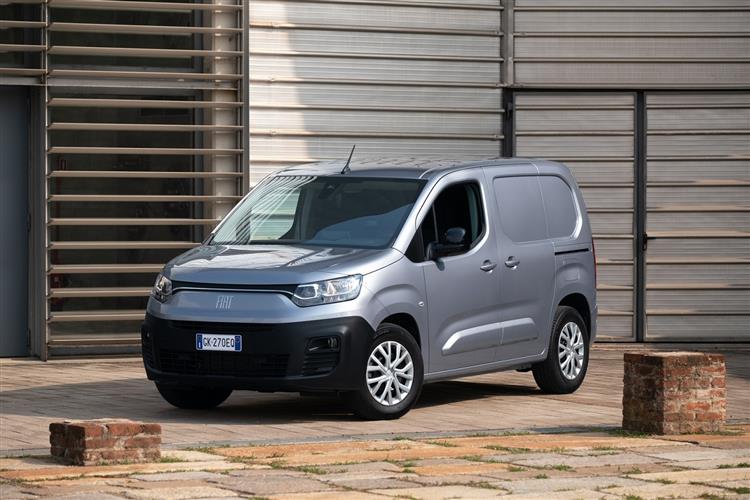A DOB TO SAVE A FEW BOB (some text hidden) --NONE--
By Jonathan Crouch
Introductionword count: 50
If you think switching to electric with a small van will save money for your business in the long term, then you'll want one that'll be well looked after. This early version of Fiat's E-Doblo might well fit the bill. And there are few practical compromises over the diesel version.
Modelsword count: 5
compact van (Electric - EV)
Historyword count: 196
Small vans are of big importance when it comes to reducing smog in our cities. With other sizes of LCV, you can see why for many operators diesel still makes sense. Small vans though, less troubled by the issues of payload and range which trip up EV vans in other categories, ought to be electric. If you run a few in your fleet but you're still wedded to the black pump, then possibly you're just waiting for the right proposition to come along. Maybe this early version of Fiat's E-Doblo could be it. Historically, the Doblo model line's been Fiat through and through, but the third generation version, launched here in mid-2022, was a platform-shared Stellantis Group design. Which meant it was essentially the same thing as a Citroen e-Berlingo, a Peugeot E-Partner or a Vauxhall Combo Electric; the Toyota Proace City Electric was the same too. Which meant that apart from the badging, the differences with this E-Doblo lay in value, service support and warranty. The E-Doblo was facelifted at the end of 2023; it's the pre-facelift 2022-2023-era models we look at here. So does this little electric LCV make sense as a used buy?
What You Getword count: 447
There are few outward signs that this is an EV van - unless you spot the badging or the charging socket. This E-Doblo might be a re-badged version of a familiar Stellantis Group small LCV design but at least from the front end, it doesn't look it. The nose gives this van its own sense of urban style, with Fiat's retro brand badge where you'd normally expect the grille to be: cooling is taken care of by a large intake lower down. As you'd expect, there are long and short wheelbase van and 5-seater Crew Cab versions. Sadly though, there's no option for the kind of high roof variant that was so useful to operators with the previous generation Doblo Cargo. Inside, the dash and instrument layout is of course as you'll find it with this model's other Stellantis cousins from this period. You'll like the 'Magic Cargo' feature, which enables the van to carry up to three people in the front seats or, alternatively, increase the cargo area's length and loading volume. The passenger-side seat can be raised and the compartment underneath used for boxes or fragile items. The 8-inch centre touchscreen comes with 'Apple CarPlay' and 'Android Auto' smartphone-mirroring. There is no lack of storage space in the cab: 16 storage points according to Fiat, these including a 15-litre area in the centre console. The dimensions are perfectly in line with the segment, with a length of 4,403mm for the short wheelbase version, ensuring an optimum effective usable length of 1.81m and a 3.3m3 capacity, sufficient to accommodate two Euro pallets. There's the usual sliding side door (you get twin slide-opening side doors on the L2 Maxi version) and with both body styles, there are the usual twin side-hinged rear doors that open to 180 degrees. That long wheelbase L2 Maxi version, which is 4,753mm long, of course provides even greater load capacity - 3.9m3. Even more space can be freed up with the clever 'Magic Cargo' feature which Fiat fitted with the plusher 'Primo' trim level. This uses a folding front passenger bench to add an extra 0.4m3, while also increasing the maximum load length by 1.3m. The E-Doblo has a braked towing capacity of 750kg for most versions, except for the L1 Primo version, which can tow 1,000kg. this E-Doblo has a braked towing capacity of 750kg for most versions, except for the L1 Primo version, which can tow 1,000kg. You can charge the 50kWh battery from a 100kW public rapid charger from 0-80% in 30 minutes. When connected to a 7kW garage wallbox, you'll need seven and a half hours to fully replenish the battery; or five hours with an 11kW wallbox.
To see the full road test text contact us on 0330 0020 227
Pictures (high res disabled)

.jpg)
|
.jpg)
|
.jpg)
| |||
.jpg)
|
.jpg)
|
.jpg)
| |||

|
Scoring (subset of scores)
Category: Vans
| Performance | |
| Handling | |
| Comfort | |
| Space | |
| Styling, Build, Value, Equipment, Depreciation, Handling, Insurance and Total scores are available with our full data feed. | |



